
Survival kits and related equipment vary from environment to individual needs. U.S. RSOG cadre have to be prepared for global operations, so their kits are adjusted for the appropriate climate and operational scheme. With that said there are some basic ingredients that make up the base of every mans kit. The following is a checklist, which should be viewed only as an example of what can be carried in a kit. All kits carried by U.S. RSOG cadre are stored in waterproof containers and are tethered to the belt or rucksack. These kits are carried while SCUBA diving and doing airborne operations, so they must be able to withstand severe shock and submersion in salt water for long periods of time. These kits literally have to sustain life when the instructor is in the field working on tactical problems. Logistical support is strictly controlled, so that the men must operate independent of the outside world. By design these types of operations test both men and equipment.
The Problem With Kits
What is the problem you say? The first thing that is wrong with survival kits is that no one carries them when they really need them. So when does an individual need a kit? That is an easy answer, he need’s it where ever he is standing at any given moment of the day. Another problem with kits is that all of us preparedness minded folks fill them with almost useless junk that we all have talked ourselves into believing we need for life or comfort in an emergency situation. Now that said every extra piece of gear that you can pack in a kit past the most important and the most basic: utility pot, 550 cord and a stout blade, is a good thing.
Basic Kit or Pocket Equipment
- Flint rod and scraper – 1 ea.
- Butane lighters- 2ea.
- Purification tablets – 1 ea.
- Signal mirror- 1ea.
- 24 fish hooks & split shot
- Large fish hook- 2 ea.
- Spool of boobytrap wire- 1 ea.
- Sewing needles- 3 ea.
- 40 ft. fishing line 10-12 lb.
- 20 ft. 550 para cord- 2 ea.
- Whet stone or knife sharpening tool- 1 ea.
- Turkey roasting oven bag
- 3-4 inch bladed cross lock folder
- Pocket survival or multi-tool
- Adventure Medical Heat sheet- 1 or 2 ea.
- Waterproof container
- Signal mirror (optional)
Details of List
Starting from the bottom of the list and working up is the waterproof container. U.S. RSOG cadre usually carry their kit in two WITZ or OTTER plastic containers. The containers are small enough to fit into a pocket. Most are carried in the two front fatigue shirt pockets or one in each cargo pants pocket. They will easily slip into a back pocket as well although it is a little tight, but doable. Heavy, ziplock, clear plastic pouches like the Aloksak are used too. The hard side WITZ and OTTER boxes have silicone seals and locking latches.
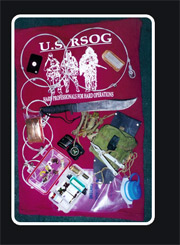 Click to View Photo
Click to View Photo
A Heat sheet is stuffed into a Ziploc freezer bag or Aloksak and dropped into a side pants cargo pocket. They are lightweight and used for everything from rock boiling water and chow in a hole in the ground, too constructing a large signal kites to the obvious shelter. There are a million uses for them, even for their intended use. Many times they are used to wrap an unlucky cold water immersion casualty in. While the rest of the team scramble to build a warming fire he sits with a ZIPPO lighter burning in his shivering cupped hands under the blanket. Space blankets get a lot of bad press. Usually from disillusioned individuals that were shocked to find out that the blanket doesn’t reflect and retain 80% of the body’s heat. As of yet we haven’t found any replacement that comes in such a convenient size. Our instructors go through hundreds of them a year.
The pocket survival or multi-tool is carried on the belt in a nylon pouch. The leather pouches do not stand up in tropical jungle environments. The tool of choice is the LEATHERMAN SUPER TOOL and the second choice is the LEATHERMAN WAVE. Cadre carry the SUPER TOOL because it is stout and like the WAVE is equipped with a saw and file. Standard wire saws are field tested on a regular basis and never seem to last through the one-year evaluation period. The saws on the LEATHERMANS just seem to keep on hacking. The blades on the tools sharpen quickly, but dull quicker than a good knife blade. The files are used for numerous improvised projects in the field. As well as minor emergency gunsmith work on the tactical weapons. The pliers are used for a lot of game skinning and cleaning projects. The bottom line, the tools are just a great piece of equipment.
Most of the folding knives carried among our personnel are BENCHMADE models of all type and configurations. All the blades are constructed from ATS-34 or 154CM stainless and have crosslocks and some serrations on the blade. Although the straight edge is preferred. BUCK ODYSSEY and CROSSLOCKs are favored in the lower end blades. More COLUMBIA RIVER blades are showing up in the planning bays before deployment time. The AL MAR SERE 2000 is well liked. As most of the preparedness community already know that condoms are used as improvised water containers. They are placed inside of a sock and the open end is stretched open then held under a stream of running water. It takes a reasonable flow rate of water to expand the condom. Blowing the condom up like a balloon before trying to fill it will make the process a lot easier. They are better than nothing but marginal at best.
A small EZE-LAP diamond sharpener is the most popular throughout U.S. RSOG ranks. It is thin, even in the leather sheath and performs very well. Some small whetstones are carried as well. The EZE-LAP diamond mini rod is popular for sharpening serrations too.
550 para-cord is probably some of the most useful product ever carried into the field. One 20 ft. hank is shoved into each back pants pocket. It flattens out and is hardly noticeable at all. Each one of the seven inner strands can be unraveled into three smaller strands and used for sewing and suture material.
Fifty feet of SPIDER WIRE fishing line is wrapped around a small piece of cardboard and tucked into any open nook.
Sewing needles with large eyes that can take 550 inner strands. A few regular sewing needles are a good for minor repairs. Pre thread those needles with 100% nylon quilters thread, you can get it at the local discount-Mart.
A spool of OD boobytrap wire out of a trip flare can be used for many different tasks. Snare wire being the obvious. 24-gauge picture wire is also an alternative to boodytrap wire and can be purchased at most hardware stores in galvanized and hunter green. We don’t use it for snares as often as we use commercial grade snares but we do use it for improvising and repairing many different primitive projects.
Two large fishing hooks that are 3 ½ inches long and 1 ½ inches wide from shaft to barb. It is lashed to the end of a sapling and used to gaff fish or frogs.
Two dozen fishing hooks are threaded across the pin shaft of a couple of safety pins. Multiple bank lines or a trotline is a very important part of fishing for sustenance. At least one lead head jig with a curly tail should be in your kit.
Every instructor carries a high quality glass signal mirror. This piece of equipment gets a large amount of use during every field exercise. Whether used to signal rotary wing aircraft, watercraft and fast movers, it is very versatile. Even ground-to-ground scenarios are set to employ the signal mirror.
POTABLE-AQUA tablets are carried in the kits. A small bottle of iodine is also used as a substitute for the tablets. The iodine is an appreciated item when in jungle environments as a disinfectant for cuts and scrapes (which are numerous).
KATADYN Micropur tablets are a good alternative to bottled tabs.
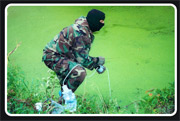 Click to View Photo
Click to View Photo
Butane lighters are carried for emergency fire starters. Butane has a long shelf life if not indefinite. They are far superior to waterproof matches and strike-any-where kitchen matches. The BIC lighters seem to be the toughest ones that we have tested. If you just have to carry matches then carry REI Stormproof matches they are without exception the best on the market.
The primary fire-starting tool is a P-65 flint rod or the Swedish made rod with the red handle. Always carry at least one or two emergency military heat tabs. They are cheap and can be gotten at almost any military surplus store or from S4. The STRIKE FORCE or BLAST MATCH are great spark throwers but a little on the large size for some kits, but we highly recommend them.
The blast whistle is mandatory for U.S. RSOG personnel as a safety rescue device. It is far louder than a human yelling. And have actually been heard through covering foliage by SAR personnel, while in a hovering chopper, during our testing. It’s all about conditions being just right, but that is loud!
An item not on the kit list but is mandatory for all of our personnel is an ACR MS-2000 (M) strobe light and spare battery or any good strobe. It is carried in a belt pouch or in a fatigue jacket pocket. It is needed for emergency nighttime med-evac. The kit equipment is used every time it goes to the field and restocked before returning. Some experts don’t advocate this practice, but we feel it is a bonus for our personnel. We want our people to be able to reach for their equipment and extract any item in the kit under dark evil conditions, preferably with either hand and not miss a beat. Nothing in the kit gets old and deteriorates. Obviously it is constantly being used and restocked.
Level II Kit
In the U.S. RSOG equipment checklist the following equipment is listed as the LEVEL II KIT, MEDIUM, LIFE SUPPORT. It is more commonly known as the “Hog Kit.” It is carried in a butt pack, or small 1500 cu. ruck. Many times it will be in a hydration packs accessory pouches or in the pouches of a tactical load-bearing vest (LBV). The items are an enhancement for an individual’s comfort level in the bush.
- Insect repellent
- Military field dressings 2ea.
- Quik-Clot blood stopper
- More 550-cord 30ft.
- “AA” or “AAA” flashlight preferably and LED
- Dehydrated sponges
- 3 inch mini cable ties- 50-75
- Peanut butter in squeeze tube or plastic jar
- Commercially made small game snares- 4-5
- Animal scent lures
- Fishing kit
- First aid kit
- Sun screen
- Dental floss or disposable dental picks
- Clear plastic trash bags 3-6 mil
- Bullion cubes
- Cooking pot
Details of List
The first item on the packing list is insect repellant with a high percentage of DEET. Insect repellent is one of the MOST IMPORTANT items on the list. Many people tout this item as a luxury item. If a stranded individual finds him/herself in the wild places without it you will curse the day that you left it out. Operating in foreign locals on a regular basis will give a person a new appreciation for the miracle of chemical technology. The feeding insect hordes will drive an individual to madness and invariably medical problems. Biting flies, mosquitoes, chiggers, fleas, ticks and a host of other bloodsuckers will do their best to infect you and drain the life from your body. U.S. RSOG personnel us a combination of SKIN SO SOFT and BEN’s 99% DEET insect repellent or MUSKOL. It’s mixed 60/40 in a spray bottle. Or carry at least two bottles of the BEN’s lotion.
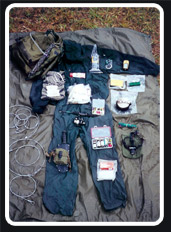 Click to View Photo
Click to View Photo
A military field dressing or two are carried to use for large wounds or it can be torn up to be used as fire starter. They are an outstanding product for either application. The Isreali Emergency dressing or the CINCN TIGHT bandage are even better.
Three ten-foot lengths of 550 para-cord are added to this kit. You just can’t have enough of this product.
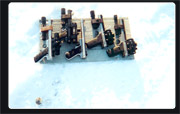 Click to View Photo
Click to View Photo
Small mini flashlights are carried. If room permits it PRICNETON TEC headlamps or Attitude flashlights are a better bet due to their waterproof casing. Headlamps are so much more versatile than a flashlight due to their hands free operation. Crawling through sewers or bombed out buildings and egress from disabled vehicles can be an issue during chaos and mayhem. There are many bombproof 3-volt lithium LEDs on the market right now to choose from.
Dehydrated sponges are thin and lightweight and are excellent for wiping dew from vegetation when collecting water.
Three-inch mini cable ties are lightweight and take up little space in the kit. They can be used for a myriad of applications such as building basket fish traps.
Peanut butter in a squeeze tube or in a plastic jar is one of the best emergency rations for a kit. Fat, protein, and carbohydrates are all covered.
The professional grade locking small game snares made from aircraft grade cable is a must for the serious survivor. They have stout hardware and swivel ends to allow the game to trash and twist around. The best that we have tested and have adopted for all snare kits are mail ordered through. Check out THE SNARE SHOP trapping supply on the web.
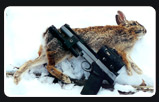 Click to View Photo
Click to View Photo
Animal scent lures swing the odds so much further in the survivor’s favor that they are one of the most coveted items in the hog kit. Most U.S. RSOG cadre carry more than one scent. The favorites are the coon, beaver, muskrat and deer. The coon, beaver and muskrat are mail ordered THE SNARE SHOP. Not all scent lures are the same quality, we have tested many different makers. KNIGHT & HALE BUCK POPPERS AND TINK’s 69 Doe-in-heat are favorites for deer snare sets or stand hunting.
A well-stocked mini fishing kit can up the odds if pole and line fishing for pan fish (perch, bluegill, crappie, etc.). A selection of lead head rubber jigs in different colors can fill a stringer in a short time. 6-8 small hooked lead heads and BERKLEY’s scent impregnated 1 ½ inch curly tail jig bodies in green, yellow, white and black jig bodies are a good start. REBEL’s smallest crank bait crawdad lure is a fish slayer as well. Add some split shot and two dozen hooks, plus a small bobber and the kit is complete.
A small first aid kit should not be over looked. One ACE wrap starts the kit, it doesn’t have to be in the first aid pouch. The minimum of contents follows: water resistant BANDAIDS, triple antibiotic ointment, aspirin, finger tip Band-Aids, tweezers, an irrigation syringe, betadine capsule swabs or a small bottle of betadine, moleskin, medicated lip ointment, IMMODIUM AD capsules, sutures, as many gauze pads as possible, anti fungal cream LOTRIMIN and medical tape. If they can be acquired some oral antibiotics.
Sunscreen of no less than SPF 30 is a lifesaver. Bad sunburns can become infected and any sunburn is a dehydrator.
Dental floss can be used for many purposes from suture to sewing material. From fishing line to trip wire. But the most important use is cleaning half-cooked wild meat dinners from between your teeth. It’s about hygiene not a Hollywood smile.
Large clear plastic trash bags are used for vegetation stills and waterproofing, 50 gallon being the best.
Since “survival soups” are part of the normal diet among our personnel the bullion cube is a treasured item (when they are allowed during the field problem). Soups are bland as wet cardboard. Hot bullion broth is a great way of bring life back into a cold weather casualty.
Probably the MOST IMPORTANT survival tool next to the blade is the cooking utility pot. A titanium or anodized aluminum pot with a non-stick surface is the tops, but stainless steel maybe more in the price range of most grunts. Check out MSR, GSI, SnowPeak and Coleman. Of course a canteen cup will do in a pinch. Or just a cheap coffee can with a wire handle.
Level III Kit
This kit is listed as LEVEL III KIT, EXSTENSIVE, LIFE SUPPORT and it is more commonly known as the “Mule” or “Jackass rig.” The equipment is usually carried in a small, 2300 cu. assault ruck. It holds more life sustaining equipment that will carry an individual through extreme conditions.
- Water purifier
- Medium game snares- (3-5)
- Deer snares- (2-4)
- Military fuel tabs- (3-6)
- Folding lightweight saw or hatchet
- Gore-Tex pants and jacket, light weight
- NALGENE CANTENE, large –(1-3)
- Small commercially made frog gig
- Hygiene products
- Drink mixes
- Emergency chow
- Sling rope and 2 snap links or 25 feet of small diameter rope
- Hydration system
- Gore-Tex socks and gloves
- Leather work gloves
- Watch cap
- Boonie type hat
- Insect Barrier or net in hot climates
- Military poncho or its equivalent
- Bungee cords (4-6)
- Light weight poly-propelene long johns
Due to the boom in technologies and development in the outdoors equipment industries, premier and inexpensive gear is to be had. One of those is the new influx of water purifiers and filters. Right now the KATADYN VOYAGER or Hiker are the favorite among our cadre. They turn putrid liquid into clean, clear water. It should not be used in water that is high in plant material with a high tannin acid content. The tea colored water clogs up the filter in quick order. Plus they will freeze up in cold climates.
Medium grade locking snares are a number one item in the field. Ready for coon, beaver and canines, it will put meat on the table.
Large deer snares make trapping deer a very reasonable endeavor. Because deer travel on established trails much like rabbits, it’s well worth the extra weight of the snares.
Military fuel tabs used for heating chow make excellent emergency fire starting equipment that will speed the drying time of wet tinder ball fuel. They produce incredible amounts of heat for approximately 6-8 minutes. Above and beyond those are the miniature backpacking stoves that we carry. They run on cheap iosobutane-propane canisters, they are an outstanding product that can speed hot fluids and chow into your half frozen body.
A lightweight folding saw is much quieter than hacking hide site camo foliage with a blade. And they are very valuable when it comes time to start producing trap triggers. We like the “T” handled models the best. If you don’t carry a saw think about a set of bush pruners or a hatchet.
Gore-Tex is a lifesaving material that is overlooked by many in the preparedness community. It stops harsh winds and rain better than most raingear materials. In the winter season Gore-Tex gloves and watch caps go into the ruck.
The NALGENE CANTENE is collapsible, very tough and very light. And it stands upright on its own. You can’t have to many of them in hot climates.
A hygiene kit consists of a small bottle of CAMPSUDS, a toothbrush and toothpaste. Good hygiene in the wild places is a must! You cannot take the risk of coming down with a bacterial infection when your body is breaking down from possible nutrient starvation.
Drink mixes like GATORADE help replenish electrolytes when dehydration is a lingering possibility.
Emergency chow is a must when evading and unable to fish and trap game. Granola bars are not a chow supplement. Cadre carry MetRx bars with 50 grams of carbs, and 25 grams of protein and peanut butter.
12-20 feet of military green line or civilian kernmantle climbing rope and snap links is carried. It has many uses from knotted hand lines for climbing or for constructing hammocks.
A military poncho or better yet a bigger tarp type of shelter is an incredible tool when it comes time to throw up a quick shelter to get out of the elements. We carry small bungee cords to use to speed up the process of rigging up the poncho, which is an old U.S. Special Forces technique from the 80’s.
A boonie hat or better than that an OUTDOOR RESEARCH Seattle Sombrero. Add a pair of sunglasses for both sun and snow glare protection.
Leather work glove will save your hands from all of the blisters, cuts and burns associated with creating a your new world in primitive living conditions.
An insect bar is just such a tremendous comfort item that is much more important than most people give it credit for. Under the right conditions you will thank God that you added this to your kit. If you don’t have it in there you will kick yourself in the ass later.
The poly-pro underwear should be carried in your ruck no matter if the weather is hot or cold. With this and your Gore-Tex gear you are ready to take on the Reaper and move through evil country in evil weather.
All U.S. RSOG personnel carry a mandatory emergency locator beacon. The ACR RAPDFIX 406 is the most recent upgrade being used.





Copyright © 2007 U.S. RSOG
 Click to View Photo
Click to View Photo Click to View Photo
Click to View Photo Click to View Photo
Click to View Photo Click to View Photo
Click to View Photo Click to View Photo
Click to View Photo